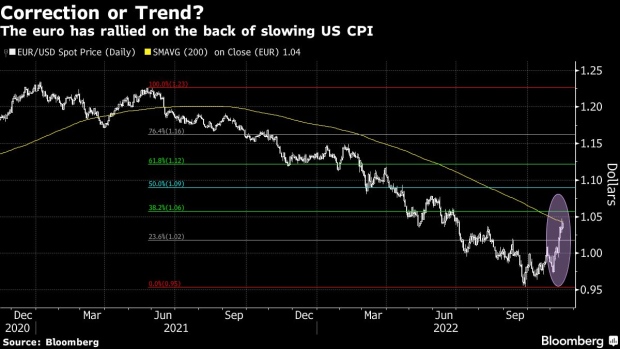Nov 17, 2022
Euro Skeptics Want Proof Its Rally Isn’t Just About the Dollar
, Bloomberg News

(Bloomberg) -- Investors caught off-guard by the euro’s sharp recovery from a two-decade low remain skeptical the rally has legs.
Helped by a massive selloff in the dollar after signs of US inflation cooling, the single currency has raced over 5% higher versus the greenback this month to its highest level since July. What’s doubtful is whether the euro can strengthen further on its own, according to UBS Global Wealth Management, Russell Investments and Insight Investment.
The currency’s brief wobble on news of a rocket striking Poland shows it’s vulnerable to selling if the Russia-Ukraine war escalates. And while it may find some support if Europe avoids an energy shortage this winter, a further, significant boost could be limited given signs that the European Central Bank may slow its pace of interest-rate hikes as it reckons with the impact of the region’s record inflation.
“The upside in the euro has probably run its course for now, unless we get another bout of stronger-than-expected data or more positive news flow on the energy situation,” said Dean Turner, economist at UBS Global Wealth Management. He expects the euro will struggle to sustain gains above 1.04 through year-end. It’s around 1.03 now.
“We don’t have a great deal of confidence that what we’ve seen is going to build into a stronger rally.”
The euro has rebounded 8% from a 20-year low in September, after falling below parity in July on fears Europe could face energy rationing in winter.
But the latest leg up has come mostly from deep selling in the dollar. Investors who were burned by premature calls for an end to the strong dollar in July want to see the trend take root this time around before making bullish bets on the single currency.
“Market participants are a bit more cautious and are willing to wait for confirmation that the dollar has peaked,” said Van Luu, head of currency and fixed-income strategy at Russell Investments. They’re “willing to miss out on the first few percent of this rally in the euro or any other currency against the dollar.”
“We are in that camp,” he said. Russell is sticking to its neutral position on the euro even after the latest rally.
The euro traded 0.6% weaker to the dollar as the greenback rebounded against all of its Group-of-10 peers on Thursday, supported by bets of higher rates in the US even as the pace of rate increases slows. Federal Reserve Bank of St. Louis President James Bullard said that 5% to 5.25% was the “minimum” policy makers should boost the rates to tame the highest inflation in 40 years. It’s at a range of 3.75% to 4% currently.
Technical Hurdles
On the technical front, the single currency needs to break above the 200-day moving average at around 1.04 to push higher. Beyond that, a bigger resistance level looms at 1.0578, a key Fibonacci retracement of the euro’s slide from mid-2021, when the Fed began telegraphing its intent to raise rates.
At the same time, a rebound for the dollar may be in the cards, as signaled by the Bloomberg Spot Dollar Index satisfying the so-called ABC correction of a complete Elliott Wave cycle since its September highs.
Demand for dollar bullish calls are resurfacing. Risk reversals, a barometer of market positioning and sentiment, show that traders are now bearish the euro once again, after briefly turning positive on its prospects last week.
Even though euro long positions have swelled to the highest since mid-2021 alongside the currency’s rebound, some investors may be waiting for more evidence to back up an argument to sell the dollar aggressively.
“You have to respect the trend, but by that same token, selling dollars after it has had a 6% move historically has tended not to be a particularly profitable strategy,” said Francesca Fornasari, head of currency solutions at Insight Investment. “The dollar has probably topped out but it is not entirely clear that you’re going to see a big move lower quite yet.”
--With assistance from Vassilis Karamanis.
(Adds pricing for the day, Fed’s comment in ninth paragraph)
©2022 Bloomberg L.P.






